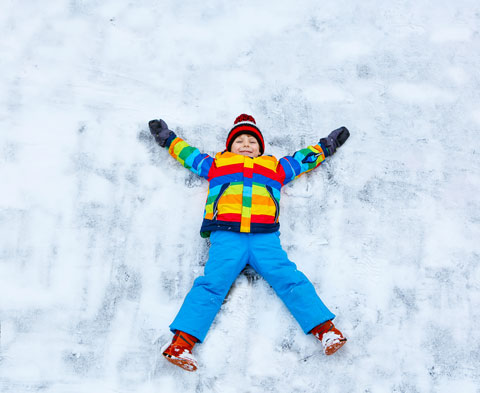Playing with snow can be an important winter-time experience for preschoolers. When children play with snow, they can strengthen their fine- and gross-motor skills. They can also apply basic principles of art, science, and engineering.
Help children to study snow as they play.
- Remind families to send children with warm clothing to allow outdoor snow play. Keep extra “winter work clothes” (mittens, snow pants, and boots) on hand for children who come to school without those items. Be sure to follow safety guidelines when deciding how long to stay outside in cold or snowy weather.
- Encourage safety and respect for others’ work by inviting children to help make rules for using snow on the playground. Factors to consider include not throwing snow, not stepping on someone else’s workspace, and keeping snow away from faces.
- Ask questions that invite children to investigate: “Which do you think is heavier—this bucket of snow or that bucket of water?” “Where is the snow deepest on the playground? Where does it melt first?” “Do you think this pile of snow will be here tomorrow?”
- Bring snow indoors for some experiments. For example, how long does it take for a snowball to melt on the playground? In the refrigerator? In the classroom?
- Try snow art. Place some snow on the sensory table and let children add large drops of colored water using basters.
Encourage children to build with snow.
- Introduce words such as pack, freeze, melt, and snowdrift. Show the class photographs of snowflakes and natural snow formations. Share nonfiction books, magazines, websites, and videos about ways that people have used snow to make structures or art.
- Let children plan structures or designs that they want to create with snow. How much space will they need? How will they shape and pack the snow? Do they want to include other items, such as sticks, sand, or ice?
- Provide sturdy buckets and shovels. Add shallow bins or pans for making bricks or blocks of snow. Some children may enjoy using yardsticks to measure snow depth.
- Throughout the winter, help children notice and describe different types of snow—dry, wet, slushy, etc. Ask them to compare what it’s like to make structures or designs with each type of snow.
Talk about snow with the children.
- During class meetings, invite children to report on their play with snow. Ask challenging questions: “How do you know that something is snow and not ice?” “What are some things you notice about snowflakes when you catch them on your gloves?”
- Let children create models of their snow structures and designs with air-drying modeling compound. Display the models along with children’s comments about their snow creations. Children may enjoy describing what they have learned in a presentation for parents or classroom visitors.
IEL Resources
- Resource Lists:


 PDF
PDF